Using image sensor and tracking filter time-to-go to avoid mid-air collisions
a technology of image sensor and tracking filter, applied in the direction of direction/deviation determining electromagnetic system, using reradiation, instruments, etc., can solve the problems of high uncertainty in ttc estimates, and drawbacks of each of the above principles for estimating ttc, etc., to achieve high degree of certainty
- Summary
- Abstract
- Description
- Claims
- Application Information
AI Technical Summary
Benefits of technology
Problems solved by technology
Method used
Image
Examples
Embodiment Construction
[0036]FIG. 1 illustrates a top view of the front half of an Unmanned Aerial Vehicle (UAV) 1. The UAV 1 comprises one or several electro-optical (EO) sensors 3 for monitoring surrounding air traffic. The EO sensors 3 constitute parts of a tracking system for continuously tracking nearby airborne objects in order to avoid midair collisions. The collision avoidance system of which the tracking system forms a part will be described in more detail below with reference to FIG. 2.
[0037]In the exemplary embodiment illustrated in FIG. 1, the UAV 1 is seen to comprise seven electro-optical (EO) sensors 3 which are arranged in a semi-circular pattern on or close to the nose of the UAV 1. The EO sensors 3 may be any devices which are able to capture consecutive images of objects in the surrounding airspace. In one embodiment of the invention, the EO sensors 3 are 9 Hz video cameras 3 capturing images having a 2048×2048 pixel resolution. That is, each camera 3 captures nine high-resolution image...
PUM
 Login to View More
Login to View More Abstract
Description
Claims
Application Information
 Login to View More
Login to View More - R&D
- Intellectual Property
- Life Sciences
- Materials
- Tech Scout
- Unparalleled Data Quality
- Higher Quality Content
- 60% Fewer Hallucinations
Browse by: Latest US Patents, China's latest patents, Technical Efficacy Thesaurus, Application Domain, Technology Topic, Popular Technical Reports.
© 2025 PatSnap. All rights reserved.Legal|Privacy policy|Modern Slavery Act Transparency Statement|Sitemap|About US| Contact US: help@patsnap.com



